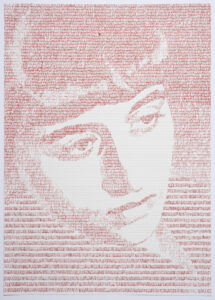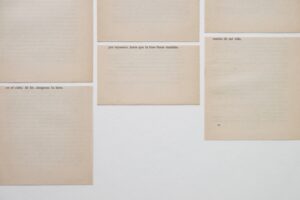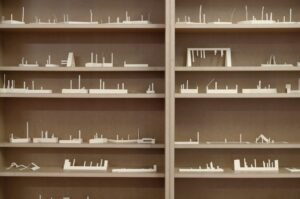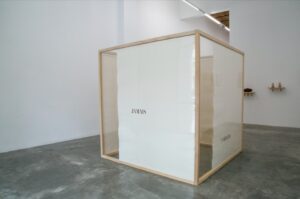Gonzalo Elvira
Bauhaus Women
Gonzalo Elvira’s proposal: Bauhaus1919, modelo para armar, refers to the level of history in relation to women’s access to art. Elvira’s installation constitutes a site-specific mural, which was to be presented at the Mercosur Biennial but, since it could not actually happen, it will be presented for the first time at ARCOmadrid 2021. With this piece, the artist takes up the history of the women who were part of of the Bauhaus, but that have been scarcely represented. Elvira reproduces on paper a series of portraits of them.

One of the aspects that caught my attention about the [Bauhaus] school was the only female presence of Günta Stolz within the faculty. Therefore, I wanted to highlight the role of women within the Bauhaus movement since they were somehow segregated into the textile and ceramic workshops. They were not allowed to participate in the blacksmithing, carpentry and architecture workshops, they alleged that the women had certain problems with three-dimensionality after the exam to enter the school.

Gonzalo Elvira. GS. 2019. Tinta sobre papel. 50 x 35 cm
Take a look at the exhibition Idilio by Gonzalo Elvira in RocioSantaCruz. The artist received the GAC Award to the Artist for the Best Exhibition in Gallery for this show.

Gonzalo Elvira. Idilio. RocioSantaCruz. 2019-2020
Mar Arza
Armario de aristas / Suertes
Mar Arza continues the dialogue of women in history and presents her series called Suertes. There is a meaning of the word LUCK (SUERTE in Spanish) that refers to the earth: ’11 .f. Part of arable land, separated from another or others by its boundaries’, can be read in the Spanish dictionary. In the SUERTES series the fragments of arable land, cultivated and cultivable spaces are concentrated. End of book chapters written by women, Carmen Laforet and Santa Teresa in this case. Where a chapter ends with a final sentence in suspense, that already present space of latent targets is concentrated, waiting for resonance.

Mar Arza. Suertes (Laforet). 2020. Puntos y aparte, final de capítulo. 85,8 x 65,8 cm. Detalle
This first E-XHIBITION proposal closes with the installation Armario de aristas, a corner shelf in homage to Jorge Oteiza’s chalk shelves, where Mar Arza arranges words on pieces of paper creating unexpected reading angles.
Mar Arza. Armario de aristas. 2020. Textos recortados sobre estantería-vitrina de DM. 160 x 222.5 x 27 cm. Detalle
Los trabajos de Mar Arza participan de algunos antagonismos —silencios contra proclamas, objetos frente a oquedades, homenajes y exabruptos—, pero un momento antes de que estos se cierren, volviéndose concluyentes, hay un giro desde el cual podemos reinscribirlos en nuevas encrucijadas discursivas. No llamaría desvelamiento a dicho proceso; por el contrario, le diría desidentificación o discrepancia.
Antes que una belleza sensible, antes que la belleza de comprender, hay algo extraordinaria y epistemológicamente hermoso en desunir eso que hasta entonces había quedado sellado a su reverso. Hay algo políticamente libre en desautorizar que una certeza tenga como antónimo una incertidumbre, que la perplejidad no sea esa forma que tenemos para mantener equidistante lo afirmativo de lo que se resiste a afirmarse.
– Valentín Roma
Take a look at the exhibition LE HASARD JAMAIS by Mar Arza at RocioSantaCruz.

Mar Arza. UN DÉ TOMBE TOUJOURS DU MÊME COTÉ. 2020. Poema en cuatro tiempos. 180 x 180 x 180 cm